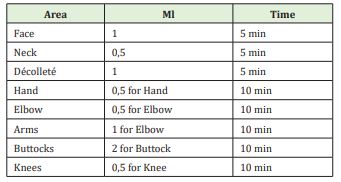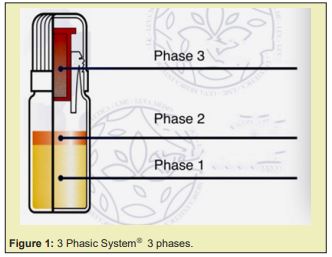Chemical peeling for skin arose in ancient culture: Egypt, Mesopotamia and Africa. Medical knowledge regarding chemical peeling is a result of centuries of experience and research. Many substances used in peeling have been described, with more or less marked action. In this work we describe the effectiveness of the 3 Phasic SystemÒ ,a system consisting of a peeling (containing various substances) associated with a topical home-based protocol. This protocol also favors the correction of incorrect eating habits also thanks to the integration with vitamins and probiotics. In this protocol a superficial peeling is used and the indications are: skin resurfacing of the face or body even in dark phototypes, outcomes of acne vulgaris, post-inflammatory hyperpigmentation, melasma, scars and photodamage. 3 Phasic SystemÒ consists of many agents in reduced concentrations, promoting the efficacy of individual agents and reducing adverse effects. However, familiarity with the properties of peels is very important to avoid adverse effects. The possibility of administering 3 Phasic SystemÒ according to a monthly schedule together with the correction of incorrect eating habits, the integration of deficient factors, the administration of probiotics and the application of correct home cosmetics has proven effective and safe in patients. The evaluation of the efficacy of the 3 Phasic SystemÒ was evaluated through ANTERA 3DÒ and VISIAÒ in 450 patients.
Keywords: Chemical peel, Skin resurfacing, 3 Phasic System, Skin rejuvenation, Aesthetic medicine
Now we define chemical peeling as the application of one or more chemical exfoliating agents of to the skin. The peel results in a rejuvenation of the skin.1 The Egyptians were among the first to use chemical peels, Cleopatra used sour milk to exfoliate and smooth the skin.2 The results obtained from chemical peeling vary according to the phototype (Fitzpatrick) and the aggressiveness of the peeling. Subjects with low phototype (Fitzpatrick type I-II) respond better to aggressive peels, obtaining better results with fewer complications.3 Phasic SystemÒ is a needle-free bio stimulation system for the skin. It is associated with an oral integration protocol using probiotics and a multivitamin complex.3 Phasic System bases its effectiveness on the concept of bio complementation, i.e. from the union of bio revitalization/bio stimulation with bio-restructuring. The intestinal microbiota plays a fundamental role in the aging and health of the organism. There are numerous therapeutic approaches targeting the microbiota: probiotics, prebiotics, nutraceuticals, functional foods, and fecal microbiota transplantation. The intestinal microbiota is linked to the quality of the skin, to aging as is now known,3-6 it is now known the close correlation between intestinal diseases, malnutrition, intolerances, etc. with the possibility of related skin diseases.7-9
Classification of chemical peels and 3 Phasic SystemÒ
Chemical peels are classified according to the depth of action.
They are divided into:10
- Very superficial that remove the horny layer of the skin
- Superficial that cause exfoliation up to the basal layer of the skin
- Mediums that draw on the papillary dermis
- Deep that grind to the reticular dermis
3 Phasic SystemÒ is a superficial peeling consisting of 3 phases Table 1:
- phase 1 (powder) consisting of different peptides but above all of pyruvic, mandelic, glycolic, salicylic, lactic, azelaic and kojic acid.
- phase 2 (lipophilic) patented complex based on bisabolol, bergamia and vitamin E.
- phase 3 (hydrophilic) various peptides and hyaluronic acid
We conducted an observational and descriptive study. We used an ANTERA 3DÒ and VISIAÒ system to evaluate the effectiveness of the 3 Phasic SystemÒ. VISIA Digital Skin Analysis is the first diagnostic tool to provide clinical measurements of superficial and deep epidermal irregularities, VISIA's photographic technology captures a clear and multidimensional image and examines age-related skin issues such as fine lines and wrinkles, hyperpigmentation, pores, skin tone uniformity (color change), porphyrins (evidence of bacterial growth), sun damage (UV spots). VISIA scans measure skin pigmentation, pore size and porphyrins. It also analyzes UV spots, sun damage, texture and wrinkles.
Antera 3D is based on an advanced optical analysis method that allows the analysis of the skin in 2 and 3 dimensions and the multispectrum analysis of the epidermis and dermis pigmentation. Antera 3D measures roughness and texture of the skin, the width, length and depth of fine lines, wrinkles and furrows. Furthermore, thanks to the use of multi-spectrum sources and the three-dimensional mapping of the skin surface, the pigmentation analysis is extremely accurate. Visia and Antera 3D allow to objectively evaluate images before and after treatment favoring an objective evaluation.
All patients underwent evaluation with Antera 3D and Visia before treatment (T0), during treatment (two week after the first session, T1) and at the end of treatment (one week after the last application, T2-T3).
The treatment protocol used consisted of 1 session every week for 4-6 weeks:
-T0 before treatment
-T1 after two treatment sessions
-T2 after 4 or 6 treatment sessions
-T3 one week after the last treatment session
The maintenance protocol provided for 1 session every month for months repeatable 2 times in the same year.
The areas of the body and face were treated according to the application time reported in the technical data sheet Table 1.
All patients from T1 began home therapy with the daily application of 3 Phasic System Cleanser and MineralizerÒ and Intense CreamÒ once a day for two months.
In addition, all patients were given one tablet a day for two months of the Entero 3 Phasic SystemÒ Table 1.

Epidemiology
In total, 450 patients, 300 women(W) and 150 men (M), were treated. The age of the treated patients is between 30 and 80 years.
The application of 3 Phasic SystemÒ was performed mainly on the face (180W-180M, buttocks (20W-20M), necks (10M- 10F), abdomen (3W- 2M), trunk (3W-2M), elbows (2W- 2M), knees (4W-2M) and back of the hands (5W-5M).
Treatment
All (450) patients were treated respecting the times and quantity of application according to the indications of the technical data sheet.
- The 360 patients treated to the face underwent a weekly treatment with 3 Phasic SystemÒ for 6 weeks. 1ml of 3 Phasic SystemÒ was used for the whole face held for 5 minutes.
- The 20 patients treated at the neck underwent a weekly treatment with 3 Phasic SystemÒ for 6 weeks. 0.5ml of 3 Phasic SystemÒ were used over the entire neck held for 5 minutes.
- The 10 patients treated at the décolleté (truck) underwent a weekly treatment with 3 Phasic SystemÒ for 6 weeks. 0.5ml of 3 Phasic SystemÒ were used over the entire décolleté for 10 minutes.
- The 4 patients treated at the elbows (arms) underwent a weekly treatment with 3 Phasic SystemÒ for 6 weeks. 0.5ml of 3 Phasic SystemÒ was used for each elbow and kept it on for 10 minutes.
- The 5 patients treated at the abdomen underwent a weekly treatment with 3 Phasic SystemÒ for 6 weeks. 1ml of 3 Phasic SystemÒ was used for each abdomen and kept it on for 10 minutes.
- The 6 patients treated at the Knees underwent a weekly treatment with 3 Phasic SystemÒ for 6 weeks. 0.5ml of 3 Phasic SystemÒ was used for each knee and kept it on for 10 minutes.
- The 45 patients treated at the buttocks underwent a weekly treatment with 3 Phasic SystemÒ for 6 weeks. 2ml of 3 Phasic SystemÒ were used for each buttock and kept it on for 10 minutes.
All patients took 1 Entero 3 Phasic SystemÒ tablet per day on an empty stomach in the morning for 60 days. In addition, all patients applied 3 Phasic System Cleanser and MineralizerÒ and Intense CreamÒ at home once a day for two months.
In aesthetic medicine there are many techniques used to improve blemishes. Peelings have conquered an increasing space over the years as they allow to obtain excellent results and to treat many imperfections: skin laxity, skin spots and wrinkles. Peelings are also cheaper and allow for easy transport with the ability to deliver the treatment easily in the clinic. The effectiveness of a peeling is linked to the power of action, however, as the depth of action increases, complications and healing time increase.
Thanks to the combination of several agents, the 3 Phasic SystemÒ makes it possible to exploit the therapeutic effect of each of these, however the low concentration limits the possibility of complications as long as the operator is trained in the application. The lack of tricloacetic acid avoids the inflammatory response associated with it which unlike other exfoliating agents involves the deposition of type 1 collagen which is of the fibrotic type11. The 3 Phasic SystemÒ stimulates the deposition of type 3 collagen which is the traditional constituent of the dermis, thanks to the absence of trichloroacetic acid in the preparation.
The 3 Phasic SystemÒ consists of 3 phases Figure 1:
- Phase 1: Arginine, hexapeptide 8, pyruvic acid, mandelic acid, glycolic acid, salicylic acid, lactic acid, azelaic acid, kojic acid.
- Phase 2: Patented complex of Citrus Bergamia oil, olive oil, bisabolol, vitamin
- Phase 3: Hyaluronic Acid, Glycine, Cysteine HCL, Valine, Proline, Lysine, Creatinine, Vitamin C, Vitamin B12

The parameters evaluated for each patient through Visia were: spots, inflammatory areas, wrinkles, pores, porphyrins and textures in the various anatomical regions treated.
The parameters evaluated by Anther 3D were Texture, skin pores dilation and hemoglobin content of the various anatomical regions treated.
With both systems, patients were evaluated at time T0 and T3
- The study on 360 patients treated with 3 Phasic System on the face and evaluated with Visia showed an average percentile improvement of 23 points in the total.
- Anther 3D showed an improvement of 0.33 i an evaluation expressed with a score between 0 and 2.
- The remaining 90 patients were treated with the 3 Phasic System in different regions of the body.
- Visia showed an average improvement of between 8-12 points.
- Anther 3D showed an average improvement between 0.27-0.35.
In conclusion, no serious or permanent adverse effects were found in any of the patients. All patients gave a positive feedback to the doctor in the control and evaluation session with Anther 3D and Visian, highlighting the manageability of post-treatment recovery. There was no difference in efficacy of the 3 Phasic SystemÒ between men and women as the results were comparable considering the same anatomical area of application and the amount and time of application. The concept introduced with the 3 Phasic System is of bio stimulation and not of resrufacing as the duration of the treatment begins with the first application and continues with topical and oral home treatments, inserting the patient into a beauty path that goes beyond the single medical treatment.
None.
None.
Authors declare that there is no conflict of interest.
- 1. Becker FF, Langford FP. A histologic comparison of 50% and 70% glycolic acid peels using solutions with various patients. Dermatol Surg. 1996:22(5):463–465.
- 2. Bryan CP. Ancient Egyptian medicine; the papyrus ebers. Chicago, IL: Ares Publishers, 1974.
- 3. Chen YE, Fischbach MA, Belkaid Y. Skin microbiota-host interactions. Nature. 2018;553(7689):427–436.
- 4. Yasmine Belkaid, Julia A Segre. Dialogue between skin microbiota and immunity. Scince. 2014:346:954–959.
- 5. Pan Chen, Guangwen He, Jingru Qian, et al. Potential role of the skin microbiota in Inflammatory skin diseases. J Cosmet Dermatol. 2021:20:400–409.
- 6. Yu Y, Dunaway S, Champer J, et al. Changing our microbiome: probiotics in dermatology. Br J Dermatol. 2020;182(1):39–46.
- 7. Cardenas de la Garza JA, Haidari W, Feldman SE. Microbiome, probiotics and dermatology. Br J Dertmatol. 2020:182:8–9.
- 8. Musthaq S, Mazuy A, Jakus J. The microbiome in dermatology. Clin Dermatol. 2018;36(3):390–398.
- 9. Baquerizo Nole KL, Yim E, Keri JE. Probiotics and prebiotics in dermatology. J Am Acad Dermatol. 2014;71(4):814–821.
- 10. Fischer TC, Perosino E, Poli F, et al. Cosmetic Dermatology European Expert Group. Chemical peels in aesthetic dermatology: an update 2009. J Eur Acad Dermatol Venereol. 2010;24(3):281–292.
- 11. Truchuelo M, Cerdá P, Fernández LF. Chemical Peeling: A Useful Tool in the Office. Actas Dermosifiliogr. 2017;108(4):315–322.

